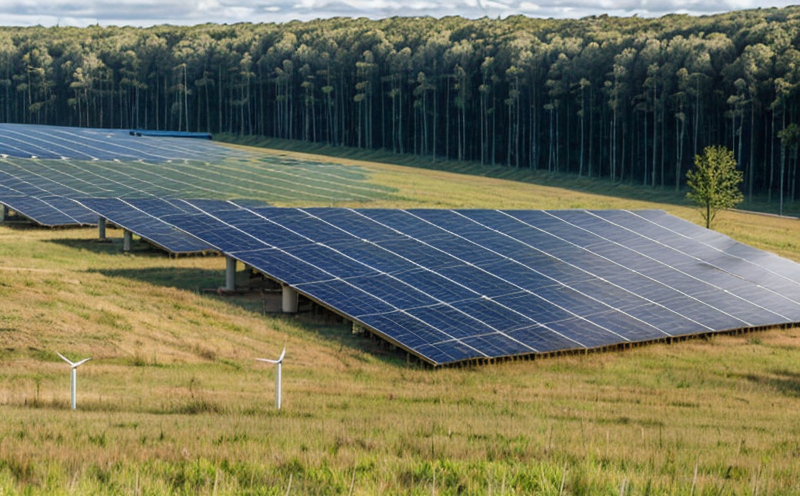ASTM E3500 Greenhouse Gas Life Cycle Modeling of Renewable Energy Test
The ASTM E3500 standard provides a framework to model and quantify greenhouse gas (GHG) emissions associated with the lifecycle of renewable energy systems. This service is crucial for understanding the environmental impact of renewable energy technologies, from raw material extraction through manufacturing, installation, operation, and decommissioning.
Our laboratory specializes in conducting ASTM E3500 tests to determine the full lifecycle GHG emissions of renewable energy projects such as wind farms, solar panels, geothermal plants, and biomass facilities. By using this methodology, clients can make informed decisions about which technologies have the least environmental footprint and contribute to more sustainable practices.
The process involves a detailed modeling approach that considers various factors including raw material extraction, processing, manufacturing, transportation, installation, operation, maintenance, and decommissioning. This holistic view helps in assessing not only direct emissions but also indirect emissions associated with renewable energy projects.
Our team of experts ensures compliance with ASTM E3500 by following stringent protocols for specimen preparation, data collection, and analysis. We utilize advanced software tools to model the lifecycle stages and produce accurate GHG emission estimates based on this detailed input.
The results from our ASTM E3500 tests are invaluable for stakeholders involved in renewable energy projects. They provide insights into how different components of a project contribute to overall carbon footprints, aiding in the optimization of processes and materials selection. Additionally, these data points can support regulatory compliance requirements and help companies meet their sustainability goals.
Our laboratory adheres strictly to ASTM E3500 guidelines ensuring that all tests are conducted under controlled conditions to maintain accuracy and reliability. Our clients benefit from this rigorous approach as they receive credible and actionable information regarding the environmental impacts of their renewable energy initiatives.
| Lifecycle Stage | Considerations for GHG Emissions Modeling |
|---|---|
| Raw Material Extraction | Evaluation of extraction methods and associated emissions. |
| Manufacturing Process | Analysis of production facilities and energy sources used. |
| Transportation | Impact assessment of shipping and delivery routes on emission levels. |
| Installation | Site preparation, equipment installation, and initial operations considerations. |
| Operation | Ongoing energy generation, maintenance activities, and waste management practices. |
| Maintenance | Periodic checks, repair procedures, and replacement of components affecting emissions. |
| Decommissioning | Elimination strategies including recycling options and disposal methods. |
The comprehensive nature of ASTM E3500 tests ensures that no aspect of the renewable energy lifecycle is overlooked when evaluating its environmental impact. This approach allows for a more precise measurement of carbon emissions, which in turn supports better decision-making processes within organizations focused on reducing their ecological footprint.
Industry Applications
- Evaluation of new renewable energy technologies before market introduction.
- Assessment of existing projects to identify potential improvements in sustainability practices.
- Supporting compliance with international environmental regulations and standards.
- Providing evidence for corporate social responsibility (CSR) reports highlighting efforts towards greener operations.
In addition, our ASTM E3500 tests are particularly beneficial for manufacturers of renewable energy components looking to demonstrate the environmental friendliness of their products throughout their lifecycle. By integrating these insights into product design and development phases, companies can enhance their market competitiveness while contributing positively to global sustainability goals.
Quality and Reliability Assurance
The ASTM E3500 standard emphasizes the importance of accurate data collection and robust methodologies when estimating greenhouse gas emissions across all lifecycle stages. Our laboratory ensures that every test adheres strictly to these standards, thereby providing reliable and consistent results.
We employ state-of-the-art equipment and software solutions designed specifically for GHG emission modeling tasks. This advanced technology allows us to capture minute details about each stage of the renewable energy lifecycle accurately. Furthermore, our experienced technicians undergo continuous training to stay updated on industry best practices and emerging trends in environmental science.
Quality assurance is at the core of what we do. We maintain strict quality control measures throughout the testing process, from initial specimen preparation through final data analysis. This commitment guarantees that all results are trustworthy and can be relied upon by our clients for strategic planning purposes related to renewable energy projects.
Environmental and Sustainability Contributions
- Supporting the transition towards a low-carbon economy by quantifying emissions reductions achievable through renewable energy technologies.
- Promoting circular economy principles via thorough evaluation of end-of-life scenarios for renewable energy components.
- Aiding in meeting international climate change commitments set forth by countries worldwide under frameworks like the Paris Agreement.
- Facilitating transparent communication between stakeholders involved in renewable energy projects regarding their environmental performance.
The insights gained from our ASTM E3500 tests play a vital role in fostering sustainable development across various sectors impacted by renewable energy initiatives. By providing clear and verifiable data on the environmental impact of different technologies, we empower decision-makers to implement measures that minimize negative effects while maximizing positive outcomes.





